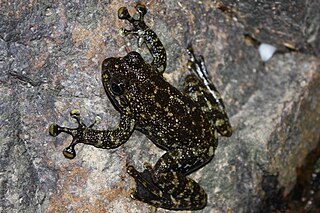
Hong Kong cascade frog or Hong Kong torrent frog is a species of true frog from southern coastal China, once thought to be endemic to Hong Kong. Their eggs are laid on rock faces in the splash zones of cascades. In Hong Kong, it is a protected species under Wild Animals Protection Ordinance Cap 170.
Amolops chakrataensis, also known as the Dehradun stream frog or Chakrata torrent frog, is a species of frog endemic to India. It is only known from its type locality near Chakrata in Uttarakhand, near the Tiger Falls. It was described based on a single specimen collected in 1985. After being "lost" for 25 years, the species was rediscovered in 2011 at its type locality, reflecting the lack of field work in the area.

Hose's frog is a true frog species with a wide range in Southeast Asia. This species was named after zoologist Charles Hose.

Amolops cremnobatus is a species of frogs in the family Ranidae. It is found in north-central Laos and Vietnam. Its range might extend into Thailand. The specific name cremnobatus is derived from Greek kremnobates, meaning "frequenter of steep places", and refers to the steep waterfall from which the type series were collected. Common name Lao sucker frog has been coined for it. Another common name is the Lao torrent frog and it has been suggested that it should change to Inger’s Lao torrent frog because new species have been described from Amolops cremnobatus and will therefore avoid confusion.

Amolops spinapectoralis is a species of frog in the family Ranidae, the "true frogs". It is at present only known from a few locations in central Vietnam—that is, it is endemic to Vietnam—but it is likely to be found more widely in the Vietnamese Central Highlands as well as in the adjacent southeastern Laos and northeastern Cambodia. The specific name spinapectoralis is derived from Latin spina for "thorn" and pectoralis for "of the breast" and refers to the pectoral spines in adult males. Common name spinyback torrent frog has been coined for it.

Amolops torrentis, commonly known as the torrent sucker frog or the little torrent frog is a species of frog in the family Ranidae and genus Amolops that is endemic to China, specifically only on the island of Hainan. They are most likely to be found in streams and surrounding wetland areas. Males have high-pitched mating calls, which are favored by females. Glands on this species' skin can secrete toxins. This species suffers from parasitism and habitat loss. Currently it is listed as vulnerable by the IUCN and is protected by law in China.
Amolops mengyangensis is a species of frog in the family Ranidae. It is known with certainty only from its type locality, the eponymous Mengyang in Xishuangbanna Dai Autonomous Prefecture, southern Yunnan province of China. However, if Amolops daorum is its junior synonym, distribution of Amolops mengyangensis would be considerably wider, including the vicinity of Sa Pa in northern Vietnam near the Chinese border, Hong Kong, and Houaphanh Province in eastern Laos, and presumably also including the intervening areas.
Meristogenys poecilus is a species of frog in the family Ranidae. It is endemic to Borneo and known from between central Sarawak (Malaysia) and central Kalimantan (Indonesia). The specific name poecilus is derived from the Greek poikolos, meaning "pied" or "blotched", in reference to diagnostic pattern on rear of the thigh. Common name Malaysian Borneo frog has been coined for this species.
Meristogenys whiteheadi is a species of frog in the family Ranidae. It is endemic to Borneo and found in both Indonesia (Kalimantan) and Malaysia. Meristogenys stigmachilus and Meristogenys stenocephalus, described as new species in 2011, were formerly included in this species. Owing to the difficulty of distinguishing these species under field conditions, the exact range of this species is uncertain. Its common name is Whitehead's Borneo frog or Whitehead's torrent frog.
Amolops daorum is a species of frog in the family Ranidae. It is known from its type locality in the vicinity of Sa Pa in northern Vietnam near the Chinese border, Hong Kong, and Houaphanh Province in eastern Laos; presumably it also occurs the intervening areas. The Hong Kong record is considered suspicious, however.
Peripatus dominicae is a species of velvet worm in the Peripatidae family. The type locality for this species is on the Caribbean island of Dominica. Although the Canadian zoologist Stewart Peck introduced the name Peripatus dominicae dominicae in 1975 to distinguish the original species from other subspecies then assigned to P. dominicae, authorities now deem these subspecies to be separate species in light of the significant distances between their type localities.
Amolops akhaorum is a species of true frogs discovered in 2007 in the Nam Ha National Protected Area, north-western Laos. It is still only known from its type locality. The specific name akhaorum refers to the local Akha people who helped with the fieldwork of the team who discovered the species.

Kachin torrent frog is a species of true frog native to Myanmar.

Amolops tanfuilianae, or Fui Lian's Lao torrent frog, is a species of true frog found in Laos and Northern Vietnam.

Amolops kottelati, or Kottelat's Lao torrent frog, is a species of true frog that is found in Laos.

Amolops sengae, or Seng's Lao torrent frog, is a species of true frog found in Laos.
Amolops australis is a species of true frog that is found in the southern parts of Peninsular Malaysia. The author proposed the common name "southern torrent frog", which is a name shared by Arthroleptides yakusini.
Amolops gerutu, the tuberculated torrent frog, is a species of true frog found in Peninsular Malaysia.
Amolops siju, the Siju Cave frog, is a species of true frog found in the Siju Cave, India.
Amolops shuichengicus, the Shuicheng torrent frog, is a species of true frog from China.








